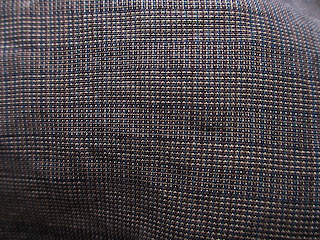The silk above just came off the loom a few days ago. Both the warp and weft thread are from the Edo period silkworm varieties. They were small cocoons with a very low percentage of sericin glue. The thread was mostly dyed with a plum tree bark and mordanted in iron mud and slaked lime. The slight variation of warm browns and cool browns are a result of a slight raising and lowering of the slaked lime bath. The greenish blue was dyed with Japanese kihada and over dyed with indigo.
The browns below come from persimmon tannin and the purples from lac dye with iron. The thread was de-gummed and then plunged into ice water to re bind the removed glue. Then dyed quickly in a cold dye bath. Later to be mordanted in a hot bath to get the small specks of white undyed random kasuri.
All the cloth above was woven from silk that was hand reeled and vegetable dyed to be made into small silk bags for tea ceremony bowls and tea caddies. The aesthetic goal was to weave something that had reached a sort of Zen Buddhist enlightenment. No ego and no desires and a quiet waiting to return to ashes with elegance and dignity. But at the same time be made of something precious. Something that looks common and almost ready to be thrown away but at a closer look is fresh and alive. Don't look at me, I'll never cause you any trouble spirit. Pretty tough parameters to fill. I think the master weavers and potters get it as they almost have one foot in the grave.






rendered speechless by the restrained beauty
ReplyDeleteI am just rendered speechless. how I wish more people could respect the depth and quality of such skill and understanding of materials
ReplyDeletethe last photo, that lovely textile, simple, profound.
ReplyDelete